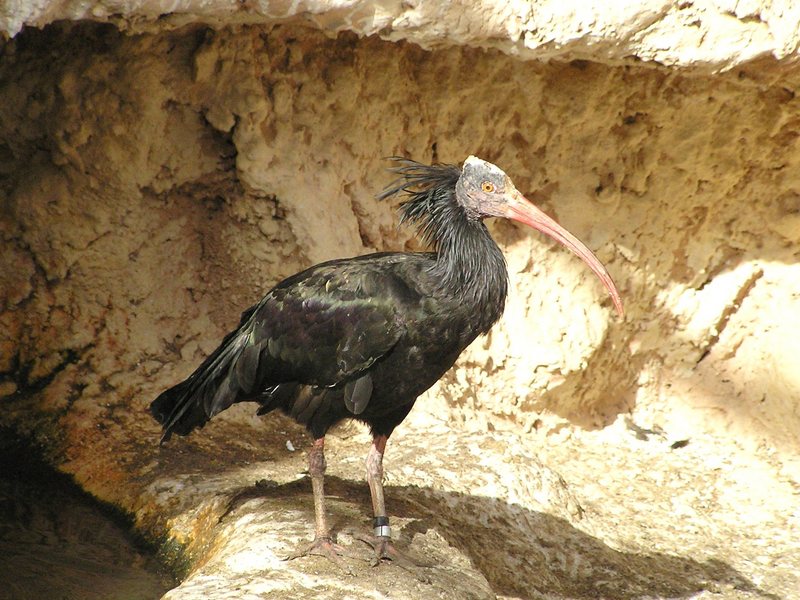Northern Bald Ibis (Geronticus eremita) - Wiki Northern Bald Ibis
From Wikipedia, the free encyclopedia
[Photo] Northern Bald Ibis (Geronticus eremita). ??????????: ???????? ?????? ?????????????????? ?????????????????????? ???? ????????. English: Taken in the Garden for Zoologic Research, Tel Aviv University, Israel. Date 2007-02-19. Author http://commons.wikimedia.org/wiki/User:Eman License: public domain.
The Northern Bald Ibis, Hermit Ibis, or Waldrapp, Geronticus eremita, is a large bird found in barren semi-desert or rocky habitats, often but not always close to running water.
This is a large glossy black ibis, 70-80 cm long with a 120-135 cm wingspan. It has an unfeathered red face and head and a long decurved red bill. It breeds colonially on cliffs in rocky deserts in the Middle East and Africa north of the Sahara, laying 2-3 eggs. Its food is insects and other small creatures. It was once much widespread across the Middle East, northern Africa and even the European Alps, though it went exinct there over 400 years ago.
It is migratory in parts of its range, but its wintering areas have recently been discovered in parts of Sudan, Ethiopia, Eritrea, and perhaps some of Somalia, Yemen, and Saudi Arabia. This species is now officially critically endangered, with an estimated population in of 420 in the wild and about 1500 in captivity (2004). It retains only a foothold in Morocco, Turkey and Syria.
Until recently the Northern Bald Ibis was believed to survive in the wild only in Morocco at Souss-Massa National Park (338 km²) where there are three colonies, and at nearby Tamri, where there is one colony containing almost half the African breeding population, with some movement of birds between these two sites.
The Turkish population was centred near the small town of Bire??ik in southeastern Turkey. During the first half of the twentieth century, the Bire??ik colony maintained a relatively stable population of about 500 breeding pairs. The first accurate count, in 1953, showed 1300 birds, including young. By the 1970s the population had drastically declined and became the subject of a captive breeding program established in 1976. This program was basically unsuccessful and in 1989 only three birds returned from their wintering grounds, all of which apparently died before they could reproduce, thus rendering them extinct in the wild in Turkey. A newly-established colony now exists at Bire??ik, but is heavily managed, with birds taken into captivity after the breeding season to prevent them from migrating.
There are different programmes ongoing to reintroduce the species into the wild in Austria (Waldrappteam.at), Spain and Italy.
Until 2002 the Northern Bald Ibis was thought to survive in the wild only in Morocco, but that year a relict colony was discovered in Syria (Serra 2003, Serra et al. 2003), where the species was regarded to have vanished more than 70 years before (Safriel 1980). Following the discovery, the Northern Bald Ibis suddenly became the rarest and most threatened animal of the Middle East.
The Northern Bald Ibis is one of the species to which the Agreement on the Conservation of African-Eurasian Migratory Waterbirds (AEWA) applies.
Cultural significance
The Northern Bald Ibis was revered by the Egyptian Pharaohs.
http://en.wikipedia.org/wiki/Northern_Bald_Ibis
| The text in this page is based on the copyrighted Wikipedia article shown in above URL. It is used under the GNU Free Documentation License. You may redistribute it, verbatim or modified, providing that you comply with the terms of the GFDL. |
